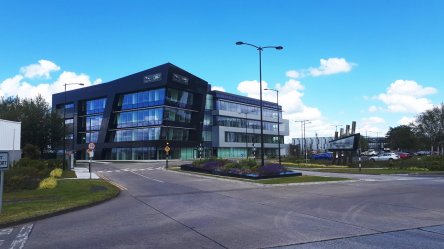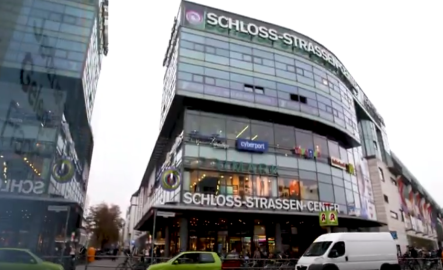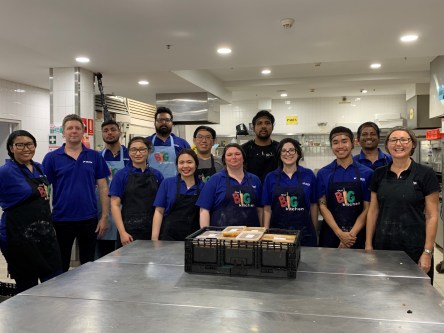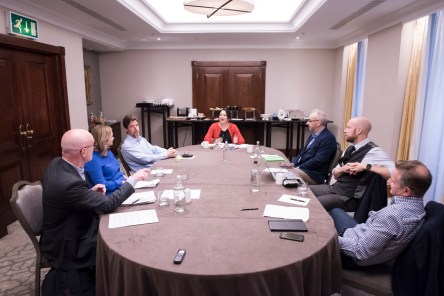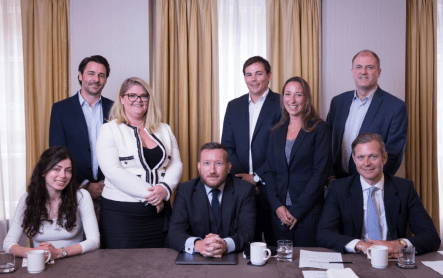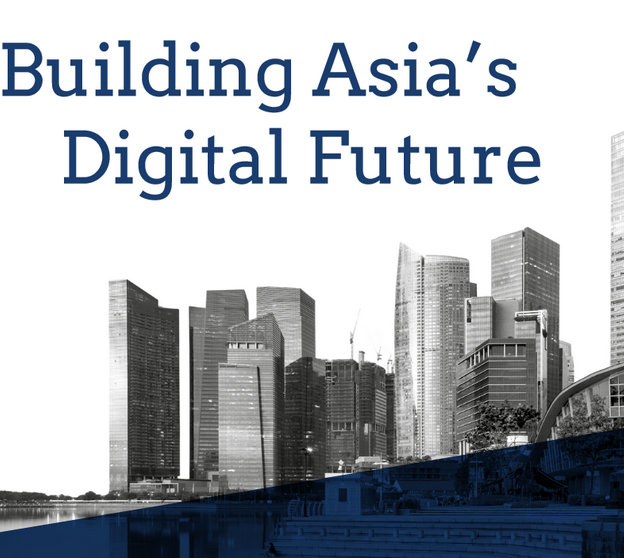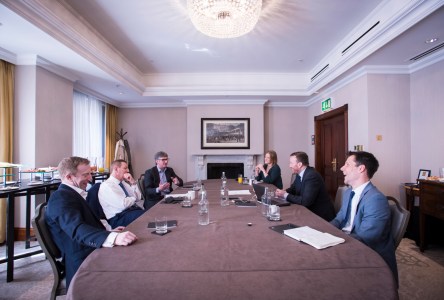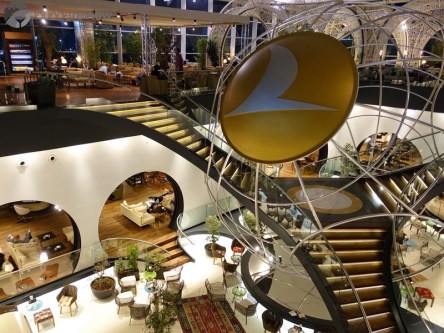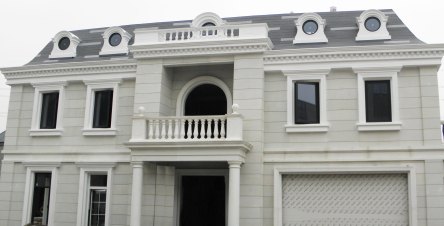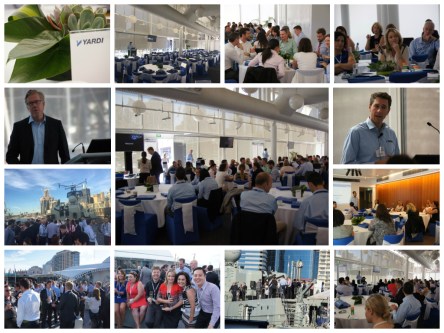According to INREV, more real estate investors are looking to allocate capital to European value-add strategies in 2020 than to core. As a notable sidebar to that finding, opportunistic investing is more apparent than at any time since the 2008 global financial crisis for those investors with a greater risk appetite. Many European investment firms are keen to attract the increased allocations reaped by Asia Pacific investors, especially those in Singapore, South Korea and Hong Kong but also China, Taiwan, Malaysia and Japan. Key factors driving this trend to invest in Europe include economic and geopolitical stability, low interest rates, desire for diversification and yield, currency trends and reliable legal environments. Europe has been the beneficiary, but many Asian investors also have a longer and more conservative investment approach with a renewed focus on core office, logistics assets and student accommodation investments in key gateway cities in the U.K., Germany and France. Many investment management firms that traditionally focused on European value-add and opportunistic strategies are also attracting capital with longer term core and core+ fund investment strategies. This turn of events is driving firms to embrace new technology as a step toward facilitating their asset strategy and decision-making process. Collaboration between all internal and external parties involved in the asset lifecycle becomes more critical than ever to facilitate informed decision-making, due to the longer-term nature of the strategy Essential elements to promoting that collaboration include: Full insight into the deal pipeline and portfolio value obtained from relevant comparisons with MLA’s and existing leases. Availability and transparency of current operational and financial data, which comprises the foundation of a comprehensive business plan. Asset managers’ ability to improve cost control, reduce risk and keep projects on track with complete budget oversight, accurate forecasts, and management of contracts, commitments and cash flows. Technology platforms that encompass the full investment management lifecycle are already helping many firms — including those working with outsourced parties, operating partners and fund administrators — drive stronger revenues while giving them instant access and full transparency into their data. Such systems have revolutionised how asset/portfolio/fund management, development and finance teams gain insight into risk, exposures and tasks during the leasing, forecasting, budgeting and development processes. As fully integrated systems, they enable superior collaboration among internal and external teams and maximise efficiency by automating business processes. Undertaking a new investment strategy can be attractive yet unsettling. Advanced real estate asset management technology can help chart a way forward that minimises risk and maximises opportunities for success. Learn how Yardi solutions promote success for real estate asset managers in Europe and...
International Outlook...
Tech will dominate the decade
Editor’s note: the below perspective on 2020 and the decade ahead for technology and real estate comes from Neal Gemassmer, vice president of international for Yardi. Originally published in Property Week, it is reprinted here with permission. The festive period was an invitation to reflect on the year gone by and the year ahead, even more so than usual. After all, it was the end of one decade and the beginning of another. Naturally enough, all eyes are on Brexit, but from a real estate perspective the impact that technology is having on our industry offers the most interesting food for thought. New technology has had a greater impact on property in the last few years than in the previous three or four decades combined. In 2010, the term ‘proptech’ had not even been coined; today, it is ubiquitous. However, in my view we have barely scratched the surface in terms of its influence. In the years to come, it will redefine how real estate functions. Here are a few ideas as to how. First, consider the build-to-rent (BTR) market. More and more investors are moving into the sector and technology has the potential to act as a major enabler. Digital technologies can allow owners and operators to cut out the middle-man – the letting agent – and communicate directly with potential customers, who can view different buildings and get a feel for the quality of the accommodation and the amenities on offer. Virtual reality lets potential tenants view a property remotely, while online tools can arrange physical visits without the need to call or email ahead. Applications and background checks can also take place digitally and customers will be able to sign their lease and pay their deposit online. The whole process will become virtually...
Yardi Client Profile
Shannon Commercial Properties
Established in 2015, Shannon Commercial Properties (SCP) is a subsidiary of Shannon Group plc and provides commercial property solutions to commercial, industrial and aviation markets. The company owns and manages seven business and technology parks and has over 1.8 million square feet of office and industrial space, as well as approximately 1,600 acres of development land in over 40 locations across counties Clare, Limerick, Tipperary, Kerry and Offaly in Ireland. “We are focused on expanding our property portfolio in the Mid West region with the provision of further third generation office and industrial facilities, primarily located in Shannon Free Zone West, beside Shannon Airport,” said Jennifer Kearns, finance manager for Shannon Commercial Properties. SCP adopted Yardi Voyager to improve business processes and to gain better control and visibility of operations in one system. The move from disparate systems enabled SCP to handle all aspects of portfolio management including lease management, reporting, budgeting, maintenance, and financials from a single database. Prior to adopting Yardi solutions, SCP was operating across six different management systems. Initially, a new structure was proposed which detailed a four-system approach: property management, financial management, debt management and document management. However, after further examination and detailed discussions with Yardi about the company’s key needs, it became apparent that SCP could streamline onto just one system, Yardi Voyager. “Streamlining onto a single system has allowed us operate with a more reliable set of data. Multiple systems had resulted in unreliable data, which had increased the potential for inaccurate reporting. Combined with the powerful reporting functionality with Voyager, SCP is far better positioned to make strategic decisions than previously,” said David Neylon, capital sales executive for SCP. Gaining control over workflows was a key driver in SCP’s move to Yardi Voyager. Voyager enables SCP...
Yardi Client Q&A...
Geji Masilela, Red Sea Markets
Yardi client Red Sea Markets Company (RSMC) owns Red Sea Mall Jeddah in Jeddah City, Saudi Arabia. Red Sea Mall is an iconic shopping and leisure destination and one of the largest shopping centres at Jeddah City. We interviewed Geji Masilela, the company’s CEO. He shared how the company’s use of Yardi Voyager helps them overcome business challenges. Q: What is your company’s background, heritage and history? A: RSMC has been existence for more than a decade. It was initially formed for the development of Red Sea Mall and other properties. Our aim for the next several years is to grow our assets under management. Q: Can you give a flavour of your company’s business culture and philosophy? A: It’s a happy and informal company culture. While we adhere to corporate norms of running a company, our leaders remain down-to-earth and approachable to our employees, customers and tenants. Q: What is your company’s brand in the current market? A: Red Sea Mall is an iconic shopping and leisure destination and one of the largest shopping centres at Jeddah City. The mall has 242,200 square meters of built area and includes a five-star hotel, a seven-story office building, and external and undercover parking areas. The mall blends international and local brands with a variety of restaurants, cafes, diners and entertainment options. Q: Could you give some understanding of the number or value of the assets involved? A: We’re still in the formative stage in terms of assets. We current have one operating asset and another asset under development. We’re actively looking for growth opportunities. Q: What’s your role? A: I’m primarily responsible for identifying and executing those growth initiatives. Q: What motivates you? A: I have a love of shopping malls, serving mall customers and...
Australia Explores Coworking
Shared workspace practice expands
As coworking continues to gain traction in office markets around Australia, Neal Gemassmer, Yardi vice president of international, looks at the top three tech trends helping landlords stay ahead of the curve. This post is reprinted with permission and originally appeared in Property Australia. More coworking space in Australia was leased in 2018 than in the previous three years combined, finds recent research from JLL. Sydney and Melbourne accounted for nearly two-thirds (60%) of all coworking space – or 95,700 sqm – leased since 2015, JLL has found. But Australia’s other capitals are also jumping on board the coworking juggernaut. Meanwhile, Colliers has recorded a 46.9 per cent increase in flexible workspace in Sydney’s CBD last year. Although, with this representing just 2.44 per cent of the market, coworking is still in its early days. Gemassmer says Australia’s large office landlords are well placed to stay ahead of the curve if they embrace the right technology. He says three tech trends are at the heart of any successful coworking strategy. Know your customer with a CRM Every coworking space should have a customer relationship management system, or CRM in place, Gemassmer says. “A CRM will streamline lead entry, customer lifecycle tracking, vendor relationship management and a host of operational tasks – driving efficiency, enhancing productivity and ultimately leading to greater profitability.” Streamline systems with automated billing Whether you operate one space or multiple locations, automated billing is one of the most vital tech components to success, Gemassmer says. “Manual entry, regardless of how meticulously done, can create leakage – and this problem is worse when you’re a multi-space operator. “Operators who streamline their business with automated billing – particularly when done so alongside other tech-driven solutions – can offer the same product, but at a higher margin and lower cost.” There are software options which combine an accounting package with merchant services, such as the Yardi KUBE, which has a full general ledger suite and accounting package, Gemassmer explains. Let’s get connected “Not all coworking enablers are tech-driven,” Gemassmer observes. “Hosting after-hours events, creating sports teams or designing spaces to encourage incidental interaction are among the many ways to build a coworking community. “But ultimately, most coworking members spend their day sitting behind a screen, and this means tech plays a central role in building and enhancing that sense of community. “Yardi’s member portal helps members book meeting space, connect with an online marketplace, access special deals and pay invoices in just a few clicks. People may be attracted to coworking for its collaborative potential, but it will be the seamless technology experience that keeps them.” The new Yardi KUBE platform allows operators to seamlessly manage their coworking space operations and financials in a fully-integrated platform while providing a phenomenal member experience. Learn...
Coworking Revolution
Becoming mainstream in UK
Increasingly, companies don’t have a five-or 10-year vision based around a particular space with a particular staff mix. They want short-term arrangements where they can flex their head count and floorspace up or down depending on need. This applies to businesses both large and small. While coworking once meant an office for four to six people, today deals are being signed for spaces that will accommodate 25, 50 or even 100 staff. Coworking also helps firms to retain the best employees by providing them with a stimulating and collaborative working environment. Sitting behind all of this is new technology which means that operating or using a coworking space is more streamlined than ever before. But with so many coworking spaces springing up, competition is getting ever more intense. So what can operators do to make their schemes are a success? Businesses today are looking for more than just a desk, a telephone and an internet connection – they want a level of service on a par with what you would expect in a high-end hotel. Years ago, we used to call the people sitting in the entrance ‘receptionists’, but today we refer to them as ‘front-of-house.’ In a successful coworking space they should engage with members, know them by name and be on hand to manage all aspects of the customer experience. Technology is a big part of this. A fast, reliable internet connection is crucial to most businesses and Yardi’s software means access to spaces is seamless, so when a member enters a coworking space they are instantly recognised and connected to the wifi. This can even work across multiple coworking locations. Unlike more traditional companies where most staff leave the building between 5pm and 6pm, some companies operating out of coworking spaces...
Meeting Challenges
Germany's Kintyre
Frankfurt, Germany-based Kintyre is a full-service real estate manager for investors in the German real estate market, offering property management, bookkeeping, leasing and tenant relations, and strategic asset management, among other services. Kintyre manages a Germany-wide portfolio valued at over €1.4 billion, totalling 800,000 square metres. The retail subsector accounts for three quarter of its assets under management, with office comprising most of the remainder. “We pride ourselves on having a team of experienced local property professionals, who have the ability to understand and deliver on our international investor’s expectations and requirements. We add value for our clients and partners through providing a fully integrated service platform, including all elements of the regular real estate management services, plus the addition of strategic retail concepts and design coordination, a strong leasing team, project management, and acquisitions and sales coordination,” says Adam Pearce, Kintyre’s managing partner. With investment returns within the German real estate market remaining under ongoing pressure, due to the current peak pricing environment, the increased use of technology is one additional tool professional real estate managers are adopting to help ensure maximum efficiency within the management process, flowing through to a value add for investors. Determined to be at the forefront of the digital revolution facing the global real estate sector, Kintyre upgraded its real estate management and accounting platform to Yardi Voyager. The decision to adopt Yardi Voyager was influenced by Kintyre’s requirements to have a single software solution that was able to operate across multiple jurisdictions and functions. “Being able to meet client standards and regulatory needs in any jurisdiction added a huge amount of confidence in the services we provide. Yardi’s innovation is global in scope but the company also knows the needs of local markets. Having such a multi-dimensional...
Our Big Kitchen
Yardi APAC Volunteers
Earlier this month, Team Yardi Australia headed to Bondi in Sydney. Switching out their laptops and phones for kitchen knives and potato peelers, the team spent the afternoons volunteering at Our Big Kitchen (OBK). OBK is about more than food, it’s a community kitchen with a soul. Created in 2000, its designed to help those in need; whether they’re going through a hard time, need a hand getting started, or are just looking for a place that provides a warm and nurturing environment. It aims not just to provide a community to its volunteers, but to help look after the millions of Australians going hungry every day. Despite being “the lucky country,” 2.2 million people in Australia go without food every year. Of those, tens of thousands come from New South Wales. OBK is on a mission to help those people, working closely with organisations such as SecondBite and Foodbank to minimize food waste and turn fresh produce into a home cooked meal. These meals are then distributed to the homeless and to regional shelters, including refuges for women and children, domestic violence shelters, asylum seekers, and more. Last year, OBK distributed over 80,000 meals to those in need. “The experience gave all the people involved a sense of reality of how good a lot of us have it in life. Giving a little bit of our time helped 200 people that day. I recommend everyone gives a little to people in need, just like we did. It was a truly uplifting experience,” said Brook Baker, regional director, Australia and New Zealand sales. For the Yardi team, the afternoons represented an opportunity to give back, whilst learning more about the darker side of the city they live in. George Karounis, founder of OBK, shared...
UK Think Tank
A Coworking Conversation
The evolution of the flexible office sector has shaken up the real estate industry and has arguably changed it for the better. Yardi recently brought together a panel of experts in the UK to discuss the many segments of flexible offices and what lies in store for the sector. Mary Finnigan, head of transactions, real estate, WeWork Chris Pieroni, operations director, Workspace Group Adrian Goldney, co-founder, Flexible Office Space John Williams, head of marketing, Instant Group Joff Sharpe, head of operations, British Land Tony Freeth, director coworking, Yardi Europe Liz Hamson, editor, Property Week – chair LH: With all the different definitions out there, what should we be calling the sector? Should there be a standard definition or does it really matter? CP: All the definitions out there are very different – hybrid, coworking, flexible, service – and then you’ve got all sorts of issues around whether they are an operator or a landlord and then you’ve got all sorts of issues about what sort of services are offered; whether they are exclusive or not. And it’s really complicated to pull all the data together and try to get an understanding. I’ve got my own view on where we stand in the flexible office market and we didn’t fit into any of the definitions. We’ve decided to just look at the flexible market. LH: So what do you define flexible as? CP: So we had three different categories – something under three months, and then we stopped at over 12 months. But actually, I think now as larger corporates want flexibility, you might be saying flexibility for them is three years. So I don’t know, but we stopped at over 12 months. JS: I don’t think the starting point is flexibility; it’s...
Coworking Takes Off
Asia market update
The global wholesale leasing model is under pressure, as technology-enabled coworking gains both momentum and market share, says Neal Gemassmer, vice president of international sales for Yardi. Shared workspace is not new – but advancing technology, the growing gig economy and cost-cutting strategies are driving the coworking trend into the mainstream. Increasingly, corporations are turning to coworking to accommodate remote employees, attract talent, promote work satisfaction and reduce leasing costs. “Technology-enabled coworking is undoubtedly putting pressure on traditional leasing models,” Gemassmer says. “Developers of A Grade office buildings have traditionally acted as wholesalers of whole or half floors of space to occupiers who must make long-term leasing commitments, and then fit out their own offices. “But technology-enabled coworking operators are using online marketing and leasing systems to efficiently offer office space to tenants at competitive rates. This is beginning to encroach on the territory of office developers. “Changes to technology does more than change behaviour. It changes the environment itself.” Gemassmer points to a recent report from Asian market intelligence source Mingtiandi, developed in partnership with Yardi, which found the growth rate of coworking in Asia had hit 40 percent in 2017. Starting as a single coworking space in New York in 2010, WeWork is one lease away from being the biggest landlord in the Big Apple. With 280-plus locations in 20 countries, WeWork is rolling out roughly 185,000 sqm of new office space every month. Around a quarter of WeWork’s clients are enterprises with more than 1,000 employees. WeWork only launched the enterprise service in 2016, and has since amassed an impressive list of clients including Facebook, Airbnb, Microsoft, Adidas, Amazon, Starbucks and LinkedIn. WeWork is just one of several coworking companies taking the region by storm, but it is the biggest. In...
Reimagining Investment...
Asia market insight
Editor’s note: The following post was written for real estate and investment professionals in Asia by Bernie Devine, Regional Director (Asia) for Yardi. With 30+ years’ experience dedicated to real estate and technology, Bernie is a leader in digital transformation in real estate and using data to create a more competitive and collaborative environment. He supports real estate clients with Retail, Commercial, Industrial, Residential and Mixed Use assets, helping them to grow their operations, create efficiencies, and gain better insight into their business. His expertise includes asset and investment management, private equity, operations improvement, program and project management, finance, technology implementation and compliance. Currently responsible for the growth of Yardi Systems in Asia, Bernie lives in Hong Kong and is a qualified accountant and economist. He has published over 60 articles and has extensive public speaking experience. I’ve recently seen a lot of discussion around the tokenisation of real estate investments. Some has been sensible, but some has missed a few key points. Two key challenges of the real estate market for the last 400 years when compared to other investment asset classes are the slow pace of transactions (it takes a long time for ownership to be transferred) and liquidity (the purchase price is so large that only a limited market of buyers exists). There have been many innovations over the years (Such as private equity funds and REITS) that have sought to address these issues, but the proptech community now thinks it may have a better solution. Tokenisation of real estate investments is about changing the way ownership of an asset is represented. It’s proposed that this change in ownership model will open up how the purchase of the asset is funded and how ownership is transferred. Basically, if ownership can be...
Build to Rent
Yardi UK Think Tank
Just a few years ago build-to-rent (BTR) was a rarely used phrase in the UK. Now it is one of the hottest real estate sectors around. A think tank of leading experts convened by Yardi and Property Week discuss the extent to which BTR has matured, the challenges it still faces and where the sector will go from here. The Think Tank Panelists: Andrew Cook – investment manager, M&G Real Estate (AC) Lora Salomidou – product owner, The Collective (LS) Rebecca Taylor – investment director, Long Harbour (RT) Katherine Rose – director of data & advisory services, Prsim (KR) John Dunkerley – chief executive and co-founder, Apache Capital (JD) Russell Markou – head of PRS operations,Tipi (RM) James Pargeter – projects director, Greystar Europe (JP) Chair: David Parsley – contributing editor, Property Week (DP) DP: How far along is BTR to becoming a mature market and is it now considered an institutional-grade investment? JD: There’s a big difference in people’s perception of where they think it is and where it actually is. There are 110,000 BTR units under construction or in planning. I don’t think we’re really scratching the surface yet. I don’t think it’s as advanced as people think it is. LS: The Collective has come from a slightly different angle to BTR and is focusing more on the consumer. The main reason we have got to where we are with BTR is because there has been a fundamental change in the expectations of consumers. The investors’ point of view is slightly different, but if we compare the return on investment from BTR to build-to-sell it is very different, because investors don’t have to manage the property – companies like us do it. JP: It’s certainly not yet mature in terms of finished...
State of Tech: Asia
YARDI/MINGTIANDI STUDY
In 2017, Yardi sponsored a survey of hundreds of real estate professionals across Asia as well the subsequent report on the survey findings. Completed by Asia real estate business intelligence source Mingtiandi, the report examines the state of technology in Asia’s real estate industry – and looks at where it’s heading. According to the report, property management technology has seen a global investment of $7.8 billion since 2013, with 60% of that investment going into Asia. Despite such hefty figures, up to 77% of Asia’s real estate professionals feel that they’re lagging technologically, citing the overwhelming reason for the region’s slow adoption of technology as resistance to change. Staying ahead of the game over the next five years will mean that managing human behavior, alongside investing in technology, will be crucial for companies looking to drive success through integrated, cohesive data and operations. Read the report executive summary and stay tuned for updates on the Yardi/Mingtiandi...
Managing Risk
UK Investment Think Tank
Yardi and Property Week assembled five property investment experts to discuss low-risk ways to find value amid fierce competition for prime property. Industrial, traditional PRS, build to rent and student housing were seen to offer opportunities, with a tough retail climate and political risk on the downside. Panelists Ian Benson: Finance Director, Kier Property Meg Brown: Director of equity placement, Colliers Howard Freedman, Partner/head of real estate and construction, RSM Jamie McCombe, Partner/head of IM, Cluttons Kris McPhail, Co-fund manager, Lime Property Fund, Aviva Moderator: David Parsley, Property Week contributing editor With prime property yields tightening and investors looking for value without too much risk, our think tank participants addressed the key issues of where funds should place their cash and what factors – both positive and negative – may affect their decisions and returns. Where are the hot sectors in real estate investment? MB: This is something we think about a lot, as we typically advise pension funds and groups where risk really matters, as they are investing money they can’t really lose. So right now we’re fans of things that are not correlated to economic cycles, and that’s largely mega-themes such as student housing, PRS and BTR, micro living and, to some degree, the co-working concept. JM: We feel capital growth is going to be more muted in this market, so there has been a flight to income return. We’ve been looking at some of those long-term income plays, such as hotels and student accommodation. The industrial sector has obviously been improving in the past 12 months, predicated on investors seeing some future rental growth, so yields have fallen quite significantly, but in the right areas and at right rent, there is still something to go for in terms of return. The prime end of the...
Better Homes
Real Estate in the UAE
Better Homes LLC in the United Arab Emirates takes pride in seeing things just a little sooner than almost everybody else. Linda Mahoney formed the company in 1986 after noticing the lack of professional real estate companies in Dubai, the country’s largest city. Since then, she and her team have dedicated themselves to understanding their markets inside out, eventually growing Better Homes into the UAE’s leading real estate company. Better Homes’ services include residential sales and leasing, commercial sales and leasing, property management, and holiday homes. The company has offices in Oman, Jordan and Qatar in addition to branch offices across the UAE. Launched as a rental agency, Better Homes opened a sales division in 2002 that has served tens of thousands of buyers and sellers. Another division created in 2015 organizes and promotes off-plan projects—properties without structures—in Dubai. Better Homes expanded from one woman working from a desk in a dining room to almost 500 employees staffing offices across the UAE. It preceded the Burj Khafila, the Burj Al Arab, the Marina, and other landmarks of Dubai’s stunning real estate development. This expansion arose from a business model that emphasized reliability, convenience, and visibility supported by a website that welcomes 24,000 page visits per day. “Every day, we look for ways to bring new and better services to our clients and maintain our market position,” says Ryan Mahoney, CEO at Better Homes. “The key for us has always been finding places for people to live. Our business is really quite simple: people and their homes. We do much more than that, of course, but people and their homes will always be at the heart of what we do.” Using the latest and most advanced property management technology is one way Better Homes executes its business with the desired level of personal service. Client service and internal efficiency were the principal factors that led Better Homes to adopt Yardi Voyager as its property management platform in 2014. “With our company growing across multiple verticals in the UAE, we needed a way to get an overview of the portfolio at one glance,” says Zubin Firozi, Director of Operations at Better Homes. “By housing financial and operational data in one place, Voyager gives us a full-business platform that covers all aspects of lease administration for every market we serve. Voyager delivers simple and understandable reports, electronic receipts and service that’s customized to each client’s unique requirements. Our staff spends less time on data entry and administrative tasks and more time managing our properties effectively—and finding homes for people. From an internal standpoint, Voyager makes data easily accessible to employees and saves money by reducing our reliance on paper.” Firozi applies more than 12 years of experience, five of them with Better Homes, to helping clients buy, rent or sell property. In his earlier role as head of property management, he oversaw an 80-member team that managed residential and commercial properties. Previous positions in business development and leasing management provided additional skills that help him back up founder Mahoney’s assertion that Better Homes is “the Middle East’s most trustworthy and dependable property agency.” “Real estate is all about the human connection. We constantly look for ways to offer new and better services to our clients. As a key collaborator and one of the world’s Top 100 private cloud companies as ranked by Forbes, Yardi helps us do that,” Firozi says. Learn more about Better Homes. This article previously appeared in Arabian...
Moving Mainstream
Coworking Picks Up Steam
No longer the sole domain of freelancers, micro busineses and start-ups, coworking is taking the Asia Pacific by storm as large companies jump on board the trend, says Yardi’s Neal Gemassmer. According to research by Cushman & Wakefield, coworking has accelerated rapidly throughout the Asia Pacific region, with roughly 750,000 sqm of space leased over the last two years alone. America’s largest coworking company, WeWork, now has 300 offices in 62 global cities, while China’s Naked Hub and Ucommune are also making waves around the region. Gemassmer, Yardi’s vice president for international business, says demand from corporates has been the one of the biggest coworking drivers. He points to research from Cushman & Wakefield, which finds the number of coworking enterprise-level companies – those with more than 500 employees – has doubled in the last 12 months. Meanwhile, the share of freelancers and independent workers has dropped by nearly 15 per cent over the last three years. “Large companies are on the hunt for space that is flexible, that enhances collaboration, and that fosters a creative culture – all characteristics of a coworking environment,” Gemassmer says. So, what are the three coworking trends to watch in 2018? Innovation acceleration “An innovation culture is an essential ingredient in a modern workplace, particularly as disruption continues to drive many companies out of business,” Gemassmer says. “Nurturing new ideas is critical to any company facing industry disruption.” Google has established community hubs, which it calls “campuses” to cultivate a community of entrepreneurs. Coders and creatives, innovators and investors can work together while locals catch up for coffee. Similarly, Unilever has set aside an entire floor of its regional headquarters in Singapore for start-ups to set up shop, and for its own team members to connect. “Coworking can...
Yardi Construction
Module Update News
Yardi Construction Management is adding features to address project management tasks. A new, customizable dashboard permits users to access subsets of the core data available in Yardi Voyager. Penny Bailey, Project Manager, Construction at Yardi explains several new functionalities that further improve the efficiencies and interface of the software. Document Organization Whether it’s an essential contract or a quick side note, the planned enhancements to Construction Management make it easier for project managers to stay organized and in control. When project managers need to access documents created in Yardi Document Management, they can now click a link on the Construction Management dashboard. “With jobs, there are thousands of documents and drawings and contracts. It’s a pain to get docs in an accessible, central repository. The link to Orion permits multiple users see documents related to that specific job without bouncing between programs,” says Bailey. Construction Management capitalizes on Yardi Document Management’s advanced search capabilities. Users can search document texts in entirety rather than titles or identification numbers alone. Sometimes, it’s the small things that have a major impact. “We’ve added a quick note icon that floats on the right side of the screen,” says Bailey. “Project managers can make notes and then quickly slide the note aside.” With this feature, users can effortlessly add, edit, and delete notes without using a separate application or uploading multiple documents. Budget On the dashboard, users can now see a real-time budget summary for multiple jobs at once. “Quick access to the current budget and actual cost numbers at a glance is invaluable in determining the status of a project,” says Bailey. The integration for Construction Management and Yardi PAYscan is now more seamless than ever. Project managers can issue approvals for contracts, address change orders, revisions and...
Epic Airports
Lounging in Global Style
Traveling long distances is no longer a burden for a few people. Almost all airlines offer relaxing areas and peaceful lobbies, but some have taken lounges to a whole new level of sophistication. So premium passengers do not get special treatment only in the sky, but also on ground. Access to a plethora of luxurious amenities varies from one airline to another – you may have to book a certain class of travel, pay a fee or use mileage points. These extravagant lounges make crappy sandwiches and people talking too loud on their phones seem like they’re from a different world. Bon voyage! Air France’s La Premiere Lounge, Paris Charles De Gaulle Airport Going to Paris is everyone’s hidden yearning, so Paris cannot afford to disappoint. This is probably the way airlines think as Air France’s La Premiere lounge in Charles De Gaulle Airport will certainly become part of an unforgettable experience. The minimalist design, the red mood lighting in the bar, the deluxe shower rooms and private relaxation suites with daybeds contribute to a pre-boarding privileged treatment. Biologique Recherche, an exclusivist spa, pampers even the most pedant passengers by offering tailor-made services meant to alleviate stress, jet lag, dehydration and the heavy legs effect. The lounge includes a library, stocked with newspapers and a wide selection of books and magazines. Michelin-starred chef Alan Ducasse’s menu completes the lounge experience with finger-licking French dishes. Staff can assist by creating a schedule that maximizes on the lounge’s amenities. (Pictured right, photo courtesy of Air France website) Etihad Airways’ Business Class Lounge at New York’s JFK International Airport This 7,500-square-foot lounge is considered to be one of the most luxurious lounges in the U.S. The unique travel environment reflects twenty-first century Abu Dhabi modernism and embodies...
Emerging Luxury
International markets
Christie’s International Real Estate Report lists Canada and Norway as the sites of the three fastest growing luxury markets. The wealthiest home shoppers in the world are investing in these unexpected locales. For years, Hong Kong, London, and New York have led the world in luxury real estate. To qualify, these cities possess a robust inventory of properties well above the world average of $2.2 million. These markets rank at the top of the pack, driving the 8 percent growth that the global luxury home market saw last year: London tops the list for the most luxurious, prime properties. It is home to the highest quantity of luxury listings as well as some of the most costly. One of the most recent luxury sales includes a $141 million estate. Hong Kong leads the group in terms of average luxury home price per square foot. Buyers easily exchange $3,000 per square foot of livable space. The sale of a 5,706-square-foot mansion at 28 Barker Road for $194 million was the crowning glory of 2015. London and New York vie for second place, both averaging about $2,000 per square foot. The three cities’ dominance in the market could be short lived. Luxury homes in these cities linger on the market longer than before. Hong Kong and London saw an increase in average days on the market in 2015. London, for example, saw an increase from 165 days to 270 days from 2014-2015. Yet worldwide, luxury homes experienced a 23 percent decrease in days on the market It seems that buyers have become increasingly interested in what other affluent cities have to offer. Auckland is the hottest city to watch, posting growth of 63 percent in 2015. A notable recent sale includes the $24 million cliff-top house...
Global Aging
Senior Living Around the World
In the U.S., the impending wave of aging baby boomers has sparked a cultural shift in senior living industry, inspiring thousands of new projects and products. But what about the rest of the world? According to United Nations Population Fund (UNFPA) report Aging in the 21st Century, “the population of people over 60 will reach 1 billion within the decade.” Even more eye-popping, 80% of the world’s seniors will live in developing countries. As the UNFPA explains, “While the trend of aging societies is a cause for celebration, it also presents huge challenges as it requires completely new approaches to health care, retirement, living arrangements and intergenerational relations.” “People everywhere must age with dignity and security.” Exporting Strategies Stateside, senior living providers have already begun to plan for the impact of millions of seniors by offering new alternatives and greater options in an effort to woo future residents. However, even more tantalizing than the millions of U.S. senior citizens poised to enter retirement are the hundreds of millions of Chinese and Indian citizens who will soon turn 65. As Forbes contributor Benjamin Shobert points out in a recent piece for the New York Times, U.S. senior living providers are perfectly positioned to capitalize on the rise of the international senior population. “With the realization that we are all living longer in mind, now is the time for American and European senior living companies to begin laying the groundwork for the globalization of senior living.” Looking East For Shobert, China and India top the list of potential markets ripe for western-style senior living offerings. By 2050, the number of Chinese citizens over 65 years in age will number well above the entire U.S. population. In consideration of this expected demographic explosion, U.S. senior care companies...
Global YASC Events
November 2015: YASC ANZ, YASC Asia
November is a busy month for our clients in Australia, New Zealand, and the rest of the Asia Pacific region. Yardi will be offering two Yardi Advanced Solutions Conferences to provide product training, learning opportunities, and networking for clients. The conferences will focus on clients with commercial and investment portfolios. At both YASC ANZ and YASC Asia, attendees can look forward to courses and panels tailored to the experience of product users, IT professionals, managers, and executives. As an added feature to the conferences, labs will be available for scheduling one-on-one demonstrations with Yardi product experts. For the first time, the conference will also offer peer roundtables on a variety of industry topics at YASC ANZ. YASC Australia/New Zealand starts November 16 in Sydney, Australia. All conference activities will be hosted at the Doltone House Hyde Park. This year, the conference has further expanded, providing attendees with four tracks of courses to choose from. In addition, guests will be able to enjoy scheduled entertainment and networking at the YASC ANZ reception on Wednesday, November 17. In less than two weeks, YASC Asia will come to Singapore, November 23-24. Conference events will be held at the Amara Sanctuary Resort on Sentosa Island. To better serve clients, YASC Asia has doubled the curriculum offered this year. The conference will feature four training tracks designed to offer clients specialised courses on Yardi software and services. Besides courses and panels, YASC Asia attendees can take advantage of discounted spa treatments at the host resort and the many networking opportunities available at the conference and cocktail reception. Follow Yardi’s social media channels for conference news, events, and information. You can follow Yardi on LinkedIn, Twitter, Facebook, Instagram, and Google+. Be sure to tag your photos on social media with the YASC Australia/New Zealand event hashtag, #YASCANZ, and the YASC Asia event hashtag, #YASCAsia. About Yardi: Now in its fourth decade, Yardi® is committed to the design, development and support of software for real estate investment management and property management. With the Yardi Commercial Suite™, Yardi Residential Suite™, Yardi Investment Suite™ and Yardi Orion® Business Intelligence, the Yardi Voyager® platform is a complete real estate management solution. It includes operations, accounting and services with portfolio-wide business intelligence and platform-wide mobility. Yardi serves clients worldwide from offices in Australia, Asia, Middle East, Europe and North America. For more information, visit www.yardi.com/anz and...
Renewable Future
Race to Carbon Neutrality
The United Nations predicts that by spring 2024 the world’s population will reach 8 billion. Meeting the energy needs of the world’s ever-growing population is a hot-button issue, especially in the context of finite carbon-based energy sources and the looming danger of irreversible climate change. While going carbon-neutral can seem like an unachievable goal in its complexity, there are trailblazers whose goals are exactly that: shifting populated environments away from fossil fuel dependency and onto a system of renewable energies. We’ll be taking a look at some the superstars of carbon-neutral environments and renewable energy trailblazers. Costa Rica The 2010 winner of the World Future Council’s Future Policy Award, Costa Rica has long been lauded for its environmental conservation and protection initiatives. But the little Latin American country was the focus of intense global acclaim in March 2015 when it announced that it has generated 100 percent of all its electricity from renewable sources for the 75 days straight of the year. The state-run Costa Rican Electricity Council (ICE) released information detailing that it had managed to avoid using any fossil fuels to generate electricity until mid-March by using a combination of biomass, wind, solar, geothermal and most importantly hydroelectric power plants, boosted by heavy rainfall experienced this year. Under normal conditions, Costa Rica already sources 88 percent of its electricity from renewable sources. Hydroelectric plants provide 68 percent of Costa Rica’s electricity followed by geothermal plants with a 15 percent share, wind farms provide 5 percent, biomass sources under one percent and solar chips in with 0.1 percent. Carbon-zero 2021 The Central American country plans to further expand its renewable power plant infrastructure in a bid to achieve carbon neutrality by 2021, as pledged six years ago. 100 megawatts worth of wind warms...
3D Printed Apartments...
A reality in China
Gutenberg invented the printing press in 1439; since then the printing industry has evolved, from printing blocks to 2D printers with the capacity of mass-producing documents in just minutes. Today, 3D printers are capable of creating pretty much anything, from mechanical parts to prosthetics to buildings. Even though it’s been 32 years since an engineer named Chuck Hull invented 3D printing, only recently the process became one of the industries of the moment for investors. From 2011 to the present day 3D printing has raised almost $4 billion, while during 1987-2010 (23 years) it raised only $300 million. Increase in interest by public investors translates into extraordinary potential and profit in the industry. 3D printing advocates say the technology will be routinely used to build homes, food, and human tissue and believe that it has the potential to revolutionize how we do everything. A good example is General Electric, which announced that it is using this technology to make the next generation LEAP airline engine that will save fuel consumption and expense. Probably the even better news is that 3D printing is no longer reserved for corporations only, but available to all. A Chinese construction firm, WinSun Decoration Design Engineering, unveiled a five-story apartment building, dubbed “the world’s tallest 3D-printed building,” along with a 11,840-square-foot neoclassical mansion, both made entirely with a giant 3D printer. The properties were built with a patented ink created from a combination of recycled construction waste. This project follows last year’s revolutionary initiative when the company built 10 affordable houses in 24 hours, each of 650 square feet at around $4,800. For the affordable project the company used four 3D printers that measure 20 feet in height, 33 feet in width, and 132 feet in length. The process is...
Yardi ANZ Conference
Sydney, Australia
Yardi’s expanding global user base was on display earlier this month as the company hosted user conferences in Sydney, Singapore and London with a record number of attendees at each conference. Yardi will host an additional annual user conference in Dubai, United Arab Emirates for its client base in the Middle East in March 2015. The Australia event was held at the Australian National Maritime Museum, in Sydney, over two days. Attendees participated in over a dozen sessions that covered a diverse range of topics including Yardi’s product roadmap together with breakout sessions focused on investment management, business intelligence, job cost, advanced accounting, budgeting, retail, mobility, facilities management, procurement, valuations and more. “We’re excited to host local user conferences across our international markets. These events allow us to strengthen the partnership with clients, allow attendees to network and provide an important channel for client feedback.” said Neal Gemassmer, Vice President, International. “And of course, it’s great to have some fun as well.” An evening social hour was hosted on the HMS Vampire, a retired Royal Navy Destroyer. The group enjoyed a special tour, light entertainment, sunset appetizers and beverages on the helipad of the ship with the Sydney skyline in the background. For more information on Yardi Australia, visit http://www.yardi.com.au A photo gallery of images from the event can be found below. Credit for all images goes to the ANZ User Conference Team especially Sham...
MIPIM Cannes March 6-9...
International Real Estate
MIPIM France is up and running at Palais des Festivals in Cannes, France. As the “leading international real estate fair”, MIPIM sets a standard of excellence by bringing together top real estate experts with international economists, investors, builders, and government officials. MIPIM publicizes the event as 4 days, 60+ conferences, and 250 speakers so there’s no shortage of information or specificity for everyone. Each year MIPIM features a country of honor; this year that country is Germany so MIPIM will be welcoming former Foreign Minister and Vice Chancellor of Germany, Joschka Fischer as the keynote speaker. Fischer will share his opinion on the global economy and the impact of the European financial crisis on real estate investments. Along with speakers like Olivier Seznec the CTO of Cisco France, Jean-Michel Six the Chief European Economist of Standard & Poor’s, and Bernhard Berg of IVG Institutional Funds there will be no shortage of information and networking taking place. If you can’t make it to Cannes this year, don’t worry, we did mention this being a “leading international” event, right? All you need to do is visit the blog to find updates and even videos; last year I had the pleasure of seeing the keynote speech by London Mayor Boris Johnson from the comfort of my own desk. You can also visit their Facebook page to vote for the People’s Choice Award and follow them on Twitter for more news and updates live from the show. If you will be in Cannes stop by and say hi to us in The London Pavilion – Stand...



